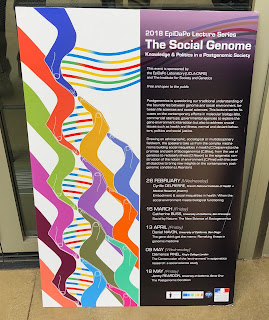Event 3: The Post-Genomic Condition: Justice, Knowledge, Life After the Genome
 |
| The Event Poster |
On May 18th, I went to Professor Jenny Reardon’s “Post-Genomic Condition: Justice, Knowledge, Life After the Genome” lecture at UCLA. She mainly focused on the issues of racial identity, justice, equality and democracy that are embedded within the science field.
She started her presentation by explaining the basics of the human genome and how there are approximately 3 millions nucleotide base pairs that made up our DNA (Reardon, 2018). Then she discussed what it means to “sequence” the human genome. By determining the order of the base pairs, we can observe the variations between species, as well as within species, at the genomic levels (Howard, 2016).
 |
| How Not to Talk about Race |
The Human Genome Project (HGP) that is responsible for this study found that there was no gene for race (NHGRI, 2016). People around the world all share the same gene regardless of their skin color. The only difference is the amount of pigment molecules that contain in our skin cells called Melanosomes (Zimmer, 2017). The more Melanosomes you have, the darker your skin is. The reason some people of European ancestry have paler skin is that they have mutations in a gene called SLC24A5, which caused cells to make less pigment, not produce pale skin (Crawford et al., 2017). It is important to note the small distinction for it is the key to dispel the concept of race and hopefully reduce all of this racial biases that plagued our American politics.
 |
| John Sulston's View on the Industry |
Another thing from the lecture that stuck with me is that many businesspeople took advantage of the medical discovery and turned it into a profit-driven industry. A standard genome sequencing would only cost one thousand dollars, but the private corporations would charge up to three thousand (Reardon, 2018). This is not the first time nor the last that we Americans have seen and experienced this inequality. It is very common in the healthcare and pharmaceutical industry (Groopman & Hartzband, 2017). Those businesspeople would not necessarily care about the people’s life or well-being as long as they earn their money.
I would recommend this event to everyone who is interested in the medical field for I think it is an eye-opener, at least with respect to the ethical issues and doing what is right. Our society is at this stage where technology could solve many issues but with the solutions come more problems. Now, there are questions of justice and equality that urgently demand our attention.
 |
| Me at the event (bad selfie skills) |
Work Cited
Crawford, Nicholas, et al. “Loci associated with skin pigmentation identified in African populations.” The Science, vol. 358, no. 6365, 17 Nov 2017. Retreived from http://science.sciencemag.org/content/358/6365/eaan8433
Groopman, Jerome and Pamela Hartzband. “Putting Profits ahead of Patients.” The New York Review of Books. 13 July 2017. Retrieved from http://www.nybooks.com/articles/2017/07/13/putting-profits-ahead-of-patients/
Howard, Jacqueline. “What Scientists Mean When They Say ‘Race’ Is Not Genetic.” The Huffington Post. 9 Feb 2016. Retrieved from https://www.huffingtonpost.com/entry/race-is-not-biological_us_56b8db83e4b04f9b57da89ed
Reardon, Jenny. “The Post-Genomic Condition: Justice, Knoweldge, Life After the Genome.” UCLA: EpiDaPo Laboratory events. 18 May 2018. Retrieved from http://socgen.ucla.edu/events/the-postgenomic-condition-justice-knowledge-life-after-the-genome/
National Human Genome Research Institute. An Overview of the Human Genome Project. 11 May 2016. Retrieved from https://www.genome.gov/12011238/an-overview-of-the-human-genome-project/
Zimmer, Carl. “Genes for Skin Color Rebut Dated Notions of Race, Researchers Say.” The New York Times. 12 Oct 2017. Retrieved from https://www.nytimes.com/2017/10/12/science/skin-color-race.html


Comments
Post a Comment